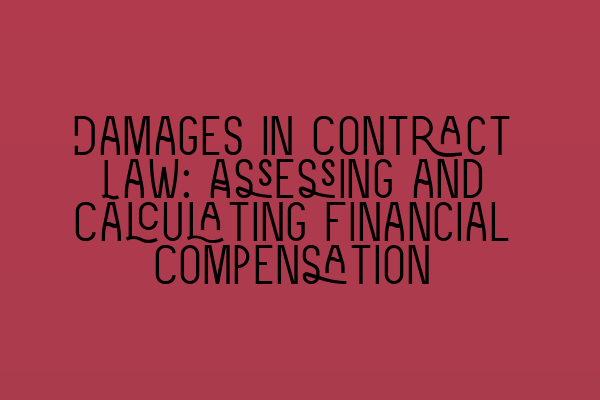When it comes to contract law, one of the key elements that parties need to consider is the issue of damages. In the event of a breach of contract, the non-breaching party may be entitled to financial compensation known as damages. Assessing and calculating damages in contract law is a complex process that requires a careful analysis of various factors. In this blog post, we will explore the different types of damages, the principles governing their assessment, and the methods used to calculate them.
Types of Damages
There are several types of damages that may be awarded in contract law:
- Compensatory Damages: Compensatory damages are intended to compensate the non-breaching party for their actual losses caused by the breach of contract. These damages aim to put the non-breaching party in the same financial position they would have been in if the contract had been performed. Compensatory damages may include both direct and consequential losses.
- Consequential Damages: Consequential damages are indirect losses that result from the breach of contract. These damages are not necessarily foreseeable at the time the contract was formed, but they are directly caused by the breach. It is important to note that consequential damages may be recoverable only if they were reasonably foreseeable by both parties at the time of contract formation.
- Nominal Damages: Nominal damages are awarded when there has been a breach of contract, but the non-breaching party has not suffered any actual financial loss as a result. These damages are typically symbolic in nature and are awarded to uphold the principle of contractual obligation.
- Liquidated Damages: Liquidated damages are a predetermined amount of damages agreed upon by the parties in the contract itself. These damages are specified in the contract to provide certainty and avoid the need for future calculations or disputes.
- Punitive Damages: Punitive damages, also known as exemplary damages, are rarely awarded in contract law. These damages are intended to punish the breaching party for their wrongful conduct and deter others from engaging in similar behavior.
Each type of damages serves a specific purpose in contract law and is awarded based on the circumstances of the case and the governing laws.
Principles Governing Damages
When assessing damages in contract law, several principles come into play:
- Principle of Compensatory Damages: The primary aim of damages in contract law is to compensate the non-breaching party for their actual losses caused by the breach. The damages should be reasonable and proportionate to the harm suffered.
- Principle of Foreseeability: Damages are generally awarded only for losses that were reasonably foreseeable by both parties at the time the contract was formed. If the breaching party could not have reasonably foreseen the potential harm, they may not be held responsible for those damages.
- Principle of Mitigation: The non-breaching party has a duty to mitigate their losses and take reasonable steps to minimize the damages. Failure to mitigate may result in a reduction of the damages award.
- Principle of Certainty: Damages must be capable of being calculated with a reasonable degree of certainty. Vague or speculative damages are unlikely to be awarded.
These principles provide a framework for assessing and calculating damages in contract law, ensuring fairness and predictability in the process.
Methods of Calculating Damages
There are various methods used to calculate damages in contract law, depending on the circumstances of the case. Some common methods include:
- Expectation Damages: This method aims to put the non-breaching party in the same financial position they would have been in if the contract had been performed. It involves calculating the difference between the value of the promised performance and the actual performance.
- Reliance Damages: Reliance damages seek to compensate the non-breaching party for the costs they incurred in relying on the contract. This method focuses on restoring the non-breaching party to the position they were in before entering into the contract.
- Restitution Damages: Restitution damages aim to restore the non-breaching party to the position they were in before the contract was formed. This method focuses on preventing unjust enrichment by the breaching party.
- Market Price Damages: Market price damages involve calculating the difference between the contract price and the market price at the time of breach. This method is commonly used when the non-breaching party can easily find a substitute for the promised performance on the market.
The method used to calculate damages will depend on the nature of the breach, the type of contract, and the specific circumstances of the case. It is important to consult with a solicitor who specializes in contract law to determine the most appropriate method for assessing and calculating damages in your particular situation.
Assessing and calculating damages in contract law is a complex process that requires a thorough understanding of the principles, types, and methods involved. It is crucial to seek professional legal advice to ensure that you are properly compensated for any losses suffered as a result of a breach of contract. To learn more about preparing for the SQE exams or to explore our SQE preparation courses, visit SQE 1 Practice Exam Questions and SQE 1 Practice Mocks FLK1 FLK2. For comprehensive SQE 2 preparation courses or further information on SQE 1 preparation, check out our SQE 2 Preparation Courses and SQE 1 Preparation Courses. To stay updated on the latest SRA SQE exam dates, visit SRA SQE Exam Dates.
